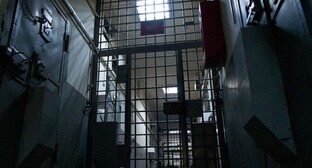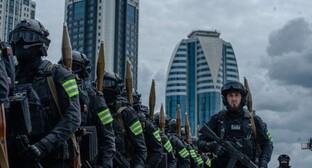29 April 2003, 04:45
Novorossiysk
City in Krasnodar kray (region), kray subordination, 136 km south-west of Krasnodar. Located on the coast of non-freezing deep-water Novorossiysk (Tsemes) Bay of the Black Sea bordered by mountains of the Markotkh Ridge (western spurs of the Greater Caucasus, up to 700 m high) in the north-east. The largest Russian port at the Black Sea (freight turnover over 9 million tons in 1990). The terminal railway station in the Novorossiysk - Crimean line (further, the line to Rostov-on-Don and Krasnodar). A motor road junction, including the Novorossiysk - Tbilisi (Georgia) and Novorossiysk - Simferopol (Crimea) highways. Airport. Population (1992 est.) 188.7 thousand, (1897 est.) 17 thousand, (1926 est.) 68 thousand, (1939 est.) 95 thousand, (1959 est.) 93 thousand, (1979 est.) 159 thousand.
Founded in 1838 as a fortification on the western coast of Sudzhuk (present Tsemes) Bay, between the mouth of the Tsemes River and the ruins of a Turkish fortress of Sudzhuk-Kale (founded in 1722, destroyed by Russian troops in 1812). The name of Novorossiysk was given in 1839. A civil settlement arose around the fortification, located at flowing of the Tsemes river into Tsemes Bay. Novorossiysk was destroyed by artillery fire of the English-French squadron during the Crimean War of 1853-1856, it was abolished in I860 and re-established in 1866. Novorossiysk was the centre of the Black Sea (Novorossiysk) okrug (district) of Kuban oblast (province) since 1866, and the centre of the Black Sea government (province) in the 1896-1920s.
In 1879, rich deposits of marls, the primary raw material for production of cement, were found in the vicinities of Novorossiysk; in 1882, Portland cement, a Black Sea company, built Zvezda, the first Novorossiysk cement factory (the present Proletariy works). In 1883, Russky Standart company commissioned a refinery. Development of the city was accelerated by driving of the Yekaterinodar - Novorossiysk railway in 1888. The station of Novorossiysk had railway workshops and a depot. The city had a soap works, a skinnery, a sausage factory, a brewery, a mill, barrel workshops and other small enterprises; fishery was also highly developed. In 1896, the joint-stock company of Vladikavkazskaya Zheleznaya Doroga completed construction of the seaport (2 jetties, 8 wharves, an eastern pier, an elevator, etc.). The port of Novorossiysk became the largest North-Caucasian centre of Russian export of grain and seeds of oil-yielding crops, as well as of petroleum, petrochemicals and cement. In 1898, Novorossiysk got the Zep cement factory (the present Oktyabr works); in 1912, 7 more cement factories were built (their number by 1917 totalled to 10).
During the Civil War, several ships of the Russian Black Sea fleet (1 battleship, 10 destroyers, etc.) were immersed in Tsemes Bay of Novorossiysk under V.I. Lenin's order of June 18, 1918. During the war, Novorossiysk was an arena of severe fights (occupied by troops of the Volunteer Army of General A.I. Denikin on August 26, 1918; by troops of the Red Army on March 27, 1920).
During the Great Patriotic War of 1941-1945, the largest part of the city was seized by Nazi troops in September 1942 (their advance was stopped in the south-east part of the city by fierce fights). At the night of February 4, 1943; a party of seamen landed in the vicinities of the settlement of Stanichka, located to the south of Novorossiysk and seized the bridgehead later called the "Malaya Zemlya" (a small piece of land), which was kept for 225 days until the city was fully liberated on September 16, 1943. During the fights for Novorossiysk, the city was almost completely destroyed and actually built up anew only to the mid-1960s. In 1973, the city was awarded the title of a Hero-City.
The marine commercial port of present Novorossiysk has berths, where ocean goers are unloaded and loaded with export-import and coasting cargoes. Novorossiysk is the largest Russian port to export cargo oil and cement. Import mostly consists of grain, industrial equipment, metals, manufactured goods and food stuffs. Transhipment of general cargoes. At the beginning of the 1990s, capacity of Novorossiysk commercial harbour did not meet increased volumes of freight traffic. Tsemes Bay has a passenger berth with marine station, a wood and a specialised fish ports. Novorossiysk remains a large centre of cement industry (4 cement factories). Engineering and metal-cutting enterprises include the plants of Моlot, Krasny Dvigatel, Pishchemash, docks, etc. Production of building materials (slates, ferro-concrete items), woodworking industry (including furniture one), flavouring industry (a mill house, a dairy factory, breweries, a fish-works). Novorossiysk State Marine Academy, the General Technical Faculty of Krasnodar Polytechnic Institute. The historical memorial reserve includes an exposition dedicated to nature and history of the city, the Exhibition Hall and the literary memorial of N.A. Ostrovsky (used to live in Novorossiysk); the Cement History Museum.
The historical centre of the city is on the western coast of Tsemes Bay, while harbour facilities and most of the enterprises are on the northern and the eastern one. Tsemes Bay, well protected from disturbances in the sea by the Sudzhuk Spit and Cape Doob, frequently experiences strong and cold north-east winds in winter (for about 50 days a year on average), the so-called Novorossiysk bora, which results in icing of vessels, damage to gardens and crops in the environs of the city. From the 1970s to the beginning of the 1990s, the ecological condition of the water area in Tsemes Bay and the atmosphere of Novorossiysk was steadily worsening. Maximum allowable pollution of air and water is often several times over.




